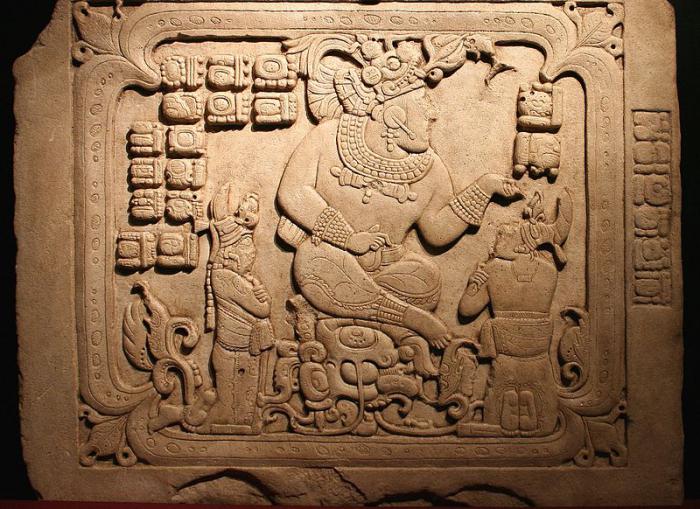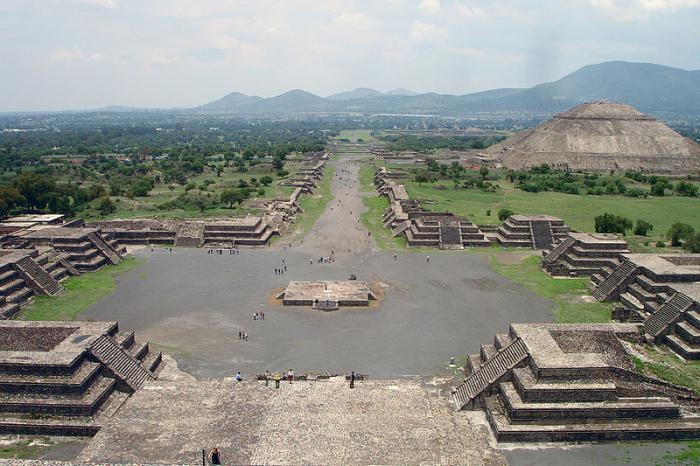The art of pre-Columbian America. Artistic achievements and architecture of the peoples of pre-Columbian America
When the first Europeans got into the Americancontinent, they encountered a civilization that was very different from everything they had seen before. Local residents had no idea about many concepts that had long been firmly entrenched in the Old World. The peoples of pre-Columbian America did not use the wheel, did not make iron tools and did not ride horses.
The more surprising is the fact that the Indians, likecalled Native Americans came from Europe, managed to build several fairly advanced civilizations. They had cities, states, long paved roads between settlements, writing, astronomy, and unique artifacts.

Civilizations of pre-Columbian America emergedindependently of each other in two geographic regions - in Mesoamerica and the Andes. Up until the Spanish conquest, these areas were centers of intellectual and cultural life of the continent.
Mesoamerica
This geographical area covers the territoriescentral and southern Mexico, Belize, Guatemala, El Salvador, Honduras, Nicaragua and Costa Rica. The first people appeared here in the 12th millennium BC. Cities and states emerged in the third millennium BC. Since then, and before the Spanish colonization began in Mesoamerica, several developed cultures emerged.
The earliest was the Olmec civilization that lived on the coast of the Gulf of Mexico. They had a huge impact on the traditions of all subsequent peoples who settled this region.
Olmec Culture
The most ancient art of pre-Columbian Americais represented by very unusual and mysterious artifacts. The most famous monument of the Olmec civilization is the giant heads, made of basalt boulders. Their sizes range from one and a half meters to 3.4 meters, and they weigh from 25 to 55 tons. Since the Olmecs did not have a written language, the purpose of these heads is unknown. Most scholars are inclined to the version that it is most likely portraits of ancient rulers. This is indicated by the details of the headdresses, as well as the fact that the faces of the sculptures are not alike.

Another area of Olmec art -jade masks. They were executed with great skill. After the disappearance of the Olmec civilization, these masks were discovered by the Aztecs, who collected and stored these as valuable artifacts. In general, the culture of pre-Columbian America was formed under the strong influence of this ancient people. Figures, statuettes and sculptures of the Olmec are found hundreds of kilometers from the once inhabited territories.
Mayan civilization
The next great culture of Mesoamerica originatedaround 2000 BC and existed until the era of European colonialism. It was the Mayan civilization, which left behind a huge number of works of fine art and architectural monuments. The highest rise in Mayan culture occurred in the period from 200 to 900 AD. In this era, pre-Columbian America experienced a flourishing of urbanism.
Frescoes, bas-reliefs and sculptures of the Maya are made withgreat grace. They quite accurately convey the proportions of the human body. Maya had a writing and a calendar, they also created a detailed map of the starry sky and knew how to predict the trajectory of the motion of the planets.
Maya Art
Color images are poorly preserved in wetclimate. Therefore, up to our days, not so many mural murals have come down. Nevertheless, fragments of such images are everywhere found in the ancient cities of this people. The surviving fragments show that the art of pre-Columbian America was not inferior to the best works of the classical civilizations of the Old World.
Maya achieved high skill in the manufacture ofceramics, including painted. From clay, they molded not only dishes, but also statuettes depicting gods, rulers, totemic animals, as well as scenes from everyday life. The Maya made jewelry made of precious stones and carved wood.

Many sculptures and bas-reliefs have been preserved, inwhich reflects the history of pre-Columbian America of that period. The Maya artists often left important events in public life that were captured in the stones. On many images there are inscriptions, which helps historians in the interpretation of the subjects presented on them.
Architecture of the Maya
The culture of America at the time of Maya experienced itsflowering, which could not but affect the architecture. In cities, apart from residential buildings, there were many specialized buildings. Being enthusiastic astronomers, the Maya built observatories to observe the celestial objects. They also had playgrounds for the ball. They can be considered predecessors of modern football fields. Sami balls made from the juice of a rubber tree.
Maya erected temples in the form of stepped pyramids,on top of which was a sanctuary. Special platforms were also constructed, reaching four meters in height and intended for holding public ceremonies and religious rites.
Teotihuacan
On the territory of modern Mexico is locatedThe abandoned city of ancient Indians with perfectly preserved buildings. Nowhere has the architecture of pre-Columbian America reached such heights (literally and figuratively), as in Teotihuacan. Here is the Pyramid of the Sun - a giant structure with a height of 64 meters and with a base more than 200 meters. Earlier at its top stood a wooden temple.

Nearby is the Pyramid of the Moon. This is the second largest structure of Teotihuacan. It was built after the Pyramid of the Sun and was dedicated to the great goddess of the earth and fertility. In addition to the two large, in the city there are several smaller four-level stepped structures.
Images in Teotihuacan
Almost all buildings in the city have frescoes. The background in them is usually red. Other colors are used to depict characters and other drawing details. Plots of frescoes are mostly symbolic and religious, illustrating the myths of pre-Columbian America, but there are also scenes of daily activities. There are also images of rulers and fighting soldiers. In Teotihuacan a lot of sculptures, including those that are elements of the architecture of buildings.
Culture of the Toltecs
Today, little is known about what wasPre-Columbian America in the period between the decline of the Mayan civilization and the rise of the Aztecs. It is believed that at this time in Toledo lived in Mesoamerica. Information about them, modern scientists derive mainly from the Aztec traditions, in which real facts are often intertwined with fiction. But archaeological finds still allow us to obtain some reliable information.

The capital of the Toltecs was the city of Tula, located on theterritory of present-day Mexico. In its place remained the remains of two pyramids, one of which was dedicated to the god Quetzalcoatl (Feathered Serpent). On its top are four massive figures depicting Toltec warriors.
The culture of the Aztecs
When the Spaniards sailed to central America, theymet there a powerful empire. It was the state of the Aztecs. On the culture of this people, we can judge not only by architectural monuments. Thanks to the Spanish chroniclers, who described the civilization they saw, information about the Aztec poetic, musical and theatrical art was preserved.
Aztec poetry
The poetic art of pre-Columbian America, according toapparently, had a long tradition. In any case, by the time of the appearance of the Spaniards, the Aztecs already had poetic contests held with a large crowd of people. In the poems, as a rule, there were metaphors, words and phrases with a double meaning. There were several literary genres: lyrical poetry, military ballads, mythological tales, etc.
Fine Arts and Aztec Architecture
The capital of the Aztec Empire was Tenochtitlan. In its construction, architectural forms dominated, which invented the pre-civilization of pre-Columbian America. In particular, over the city towered a 50-meter pyramid, resembling similar structures of the Maya.
Figures and bas-reliefs of the Aztecs depict both scenesfrom everyday life, and a variety of historical and cult events. There are also pictures of human sacrifices that were held during religious festivities.

One of the most unusual and mysteriousartifacts of the Aztecs is the Stone of the Sun - a large round sculpture, with a diameter of almost 12 meters. In the center of it is depicted the god of the Sun, surrounded by the symbols of the four past eras. A calendar is written around the deity. It is believed that the Sun Stone served as a sacrificial altar. In this artifact, the culture of pre-Columbian America reveals several of its facets at once - astronomical knowledge, cruel rituals, artistic mastery merge into a single whole.
Inca culture
The peoples of pre-Columbian America reached a highlevel of development not only in the central part of the continent. In the south, in the Andes, a unique Inca civilization flourished. This people were geographically separated from Mesoamerican cultures and developed separately.
The Incas have achieved high skill in many formsarts. Of great interest are their patterns on tissues, called tokapu. Their purpose was not only to make clothes more elegant. Each of the elements of the pattern was also a symbol denoting a word. Being located in a certain sequence, they formed phrases and sentences.
Music of the Incas
The musical art of pre-Columbian Americapartly preserved in the Andes, where the descendants of the Incas live, to the present day. There are also literary sources of the times of colonization. Of these, we know that the Incas used a variety of wind and percussion instruments. Music accompanied religious rites, many songs were associated with the cycle of fieldwork.
Machu Picchu
The Incas also became famous for their unique city,built high in the mountains. He was discovered in 1911 already abandoned, so his real name is not known. Machu Picchu in the language of local Indians means "old peak". The buildings in the city are made of stone. Blocks are so precisely adjusted to each other that the skill of ancient builders surprises even modern specialists.

Culture of North America
The Indians, who lived north of present-day Mexico,did not erect stone buildings, such as the Pyramid of the Sun or Machu Picchu. But the artistic achievements of the peoples of pre-Columbian America, who lived in the territory of the Mississippi and Missouri rivers, are also quite interesting. In this region, many ancient burial mounds have survived.
In addition to simple mounds in the form of a hill, in the valleythe Mississippi River meets stepped platforms, as well as mounds, in the outlines of which the figures of various animals, in particular the snake and crocodile, are guessed.
The influence of the art of pre-Columbian America on modernity
The civilizations of the ancient Indians remained in the past. But the current culture of America bears the imprint of ancient pre-colonial traditions. Thus, the national costumes of the indigenous peoples of Chile and Peru are very similar to those of the Incas. In the paintings of Mexican artists are often found stylistic devices, typical for the fine art of the Maya. And in the books of Colombian writers fantastic events are intricately interwoven into a realistic plot with the usual ease for Aztec poetry.
</ p>




